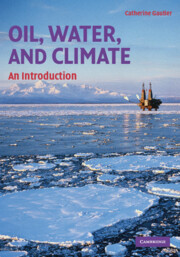Book contents
- Frontmatter
- Contents
- Foreword
- Introduction
- 1 Overview
- 2 Carbon Dioxide Emissions, Global Warming, and Water Resources
- 3 Population, Environmental Impacts, and Climate Change
- 4 Carbon Cycle and the Human Impact
- 5 Peak Oil, Energy, Water, and Climate
- 6 Oil Consumption and CO2 Emissions from Transportation
- 7 Oil, Economy, Power, and Conflicts
- 8 Energy Alternatives and Their Connection to Water and Climate
- 9 The Water Cycle and Global Warming
- 10 Fresh Water Availability, Sanitation Deficit, and Water Usage: Connection to Energy and Global Warming
- 11 Rivers, Lakes, Aquifers, and Dams: Relation to Energy and Climate
- 12 Water Contamination, Energy, and Climate
- 13 Geopolitics of Water and the International Situation
- 14 Water Alternatives
- 15 Global Climate Change: Observations, Modeling, and Predictions
- 16 Energy and Water Challenges and Solutions in a Changing Climate Framework: Commonality, Differences, and Connections
- References
- Index
15 - Global Climate Change: Observations, Modeling, and Predictions
Published online by Cambridge University Press: 05 September 2012
- Frontmatter
- Contents
- Foreword
- Introduction
- 1 Overview
- 2 Carbon Dioxide Emissions, Global Warming, and Water Resources
- 3 Population, Environmental Impacts, and Climate Change
- 4 Carbon Cycle and the Human Impact
- 5 Peak Oil, Energy, Water, and Climate
- 6 Oil Consumption and CO2 Emissions from Transportation
- 7 Oil, Economy, Power, and Conflicts
- 8 Energy Alternatives and Their Connection to Water and Climate
- 9 The Water Cycle and Global Warming
- 10 Fresh Water Availability, Sanitation Deficit, and Water Usage: Connection to Energy and Global Warming
- 11 Rivers, Lakes, Aquifers, and Dams: Relation to Energy and Climate
- 12 Water Contamination, Energy, and Climate
- 13 Geopolitics of Water and the International Situation
- 14 Water Alternatives
- 15 Global Climate Change: Observations, Modeling, and Predictions
- 16 Energy and Water Challenges and Solutions in a Changing Climate Framework: Commonality, Differences, and Connections
- References
- Index
Summary
Observational evidence of global climate change includes increases in global and regional surface temperature, extent of snow/ice, sea-level rise, hurricanes, and ocean heat content; polar amplification of anthropogenic warming (Arctic); and possible alterations in the thermohaline/meridional overturning circulation. Complex feedbacks modify the response of climate to external factors; climate sensitivity determines this response. Some inertia exists in the climate system that can eventually lead to abrupt changes if the climate system reaches a tipping point. Climate models are used to investigate future climate change and provide predictions. One of the difficulties in making predictions is disentangling natural from anthropogenic effects.
Introduction
As seen in Chapter 2, emissions of CO2 and other greenhouse gases from the burning of fossil fuels, the clearing of forests, and other human activities have been accelerating over the past century. Earth's climate is particularly sensitive to greenhouse gases because they remain in the atmosphere and modify the radiation balance of the planet for decades or even centuries. The consequence is an increase in global surface temperature (or global warming) and, more broadly, climate changes. Rising temperatures can have a profound impact on many aspects of Earth's climate, in particular on the heat content of the ocean and the melting of glaciers and polar ice. Ongoing warming also has the potential to produce more extreme heat and drought, rising sea levels, and more intense tropical storms.
Many signs associated with global warming are already evident, including rising worldwide temperatures and accelerated melting of Arctic ice.
- Type
- Chapter
- Information
- Oil, Water, and ClimateAn Introduction, pp. 288 - 309Publisher: Cambridge University PressPrint publication year: 2008



